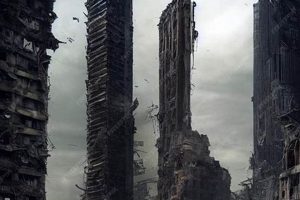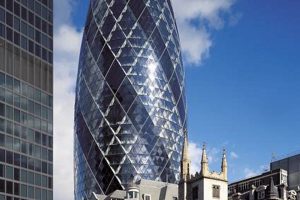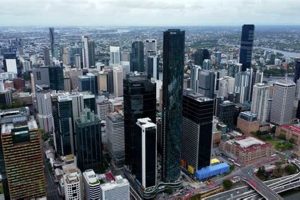Skyscrapers are designed to sway, it’s a natural response to strong winds. The swaying motion helps to dissipate the energy of the wind and prevents the building from collapsing. The amount of sway is carefully calculated by engineers to ensure that the building remains safe and comfortable for occupants.
Skyscrapers are built with a variety of structural systems to resist sway, including: Moment frames: These are rigid steel frames that are designed to resist lateral forces.Braced frames: These are steel frames that are braced with diagonal members to resist lateral forces. Shear walls: These are concrete or steel walls that are designed to resist lateral forces.Outrigger systems: These are trusses that are located at the top of the building and are connected to the core of the building to resist lateral forces.
The swaying of skyscrapers is a complex phenomenon that is influenced by a number of factors, including the height of the building, the mass of the building, the stiffness of the building, and the wind speed. Engineers use a variety of techniques to minimize the sway of skyscrapers, including: Tuning the mass damper: This is a device that is located at the top of the building and is designed to absorb the energy of the wind.Using active control systems: These systems use sensors to detect the movement of the building and then use actuators to counteract the movement.
1. Natural response
Skyscrapers are designed to sway in response to strong winds. This swaying motion is a natural response to the forces of nature and helps to dissipate the energy of the wind, preventing the building from collapsing. The amount of sway is carefully calculated by engineers to ensure that the building remains safe and comfortable for occupants.
- Wind Resistance
Skyscrapers are designed to withstand strong winds. The swaying motion helps to dissipate the energy of the wind and prevents the building from collapsing. - Earthquake Resistance
Skyscrapers are also designed to withstand earthquakes. The swaying motion helps to absorb the energy of the earthquake and prevents the building from collapsing. - Comfort for Occupants
The swaying motion of skyscrapers is carefully calculated to ensure that the building remains comfortable for occupants. The amount of sway is typically not noticeable to occupants, but it can help to reduce the feeling of dizziness or motion sickness that can be caused by tall buildings. - Structural Integrity
The swaying motion of skyscrapers helps to maintain the structural integrity of the building. The swaying motion helps to dissipate the energy of the wind and earthquakes, preventing the building from collapsing.
The natural response of skyscrapers to sway is a key factor in ensuring the safety and stability of these buildings. Engineers use a variety of techniques to minimize the sway of skyscrapers, including tuning the mass damper and using active control systems. These systems work together to ensure that skyscrapers remain safe and comfortable for occupants, even in the most extreme conditions.
2. Wind energy dissipation
Skyscrapers are designed to sway in response to strong winds. This swaying motion helps to dissipate the energy of the wind, preventing the building from collapsing. The amount of sway is carefully calculated by engineers to ensure that the building remains safe and comfortable for occupants.
Wind energy dissipation is a key component of skyscraper design. Without it, skyscrapers would be much more likely to collapse in high winds. Engineers use a variety of techniques to dissipate wind energy, including:
- Aerodynamic design: The shape of a skyscraper can be designed to reduce wind resistance. This can be done by tapering the building towards the top, or by adding features such as setbacks and chamfers.
- Structural damping: Damping systems can be added to a skyscraper to absorb wind energy and reduce sway. These systems can be passive, such as tuned mass dampers, or active, such as active control systems.
Wind energy dissipation is a critical safety consideration for skyscrapers. By dissipating the energy of the wind, engineers can ensure that skyscrapers remain safe and stable, even in the most extreme weather conditions.
3. Structural systems
Structural systems play a crucial role in managing the swaying of skyscrapers. These systems are designed to resist lateral forces, such as wind and seismic loads, and maintain the stability of the building. Engineers employ various structural systems to mitigate sway, each with its unique characteristics and applications.
- Moment frames
Moment frames are rigid steel frames that resist lateral forces by bending. They are commonly used in low- to mid-rise buildings and can provide good resistance to both wind and seismic loads. - Braced frames
Braced frames are steel frames reinforced with diagonal bracing members. These braces resist lateral forces by tension and compression, making them suitable for taller buildings. They are particularly effective in resisting wind loads. - Shear walls
Shear walls are vertical walls made of concrete or steel that resist lateral forces by shear deformation. They are commonly used in high-rise buildings and provide excellent resistance to both wind and seismic loads. - Outrigger systems
Outrigger systems consist of trusses or beams that extend from the core of the building to the exterior columns. They help to transfer lateral forces away from the core and reduce sway. Outrigger systems are often used in supertall skyscrapers.
The selection of an appropriate structural system depends on factors such as the height of the building, the expected wind and seismic loads, and the architectural design. By carefully designing and implementing these systems, engineers can effectively control sway and ensure the safety and stability of skyscrapers.
4. Moment frames
Moment frames are a type of structural system used to resist lateral forces, such as wind and seismic loads, in buildings. They are commonly used in low- to mid-rise buildings and can provide good res
istance to both wind and seismic loads, making them a suitable choice for skyscrapers that are prone to swaying.
- Components
Moment frames consist of rigid steel frames that are designed to resist lateral forces by bending. The frames are typically composed of columns and beams that are connected using moment-resisting connections, which allow the members to rotate relative to each other while resisting bending moments. - Examples
Moment frames are used in a wide range of buildings, including low- to mid-rise office buildings, residential buildings, and industrial buildings. Some notable examples of buildings that use moment frames include the Empire State Building and the John Hancock Center. - Implications for “do skyscrapers sway”
Moment frames help to reduce sway in skyscrapers by providing stiffness and strength to the building’s structure. The rigid steel frames resist lateral forces by bending, which helps to dissipate energy and reduce the amount of sway that would otherwise occur. This makes moment frames an effective structural system for skyscrapers that are prone to swaying due to wind or seismic loads.
Moment frames are an important structural system for skyscrapers because they provide good resistance to both wind and seismic loads. By using moment frames, engineers can design skyscrapers that are safe and stable, even in areas that are prone to high winds or earthquakes.
5. Braced frames
Braced frames are a type of structural system used to resist lateral forces, such as wind and seismic loads, in buildings. They are commonly used in taller buildings, including skyscrapers, to provide additional strength and stability. Braced frames work by transferring lateral forces from the building’s exterior to its core, where they can be resisted by the building’s structural elements.
Braced frames consist of diagonal steel members that are connected to the building’s columns and beams. These diagonal members are designed to resist tension and compression, which helps to stabilize the building and reduce sway. Braced frames are particularly effective in resisting wind loads, as they can transfer lateral forces to the building’s core quickly and efficiently.
The use of braced frames is an important factor in mitigating sway in skyscrapers. By providing additional strength and stability, braced frames help to reduce the amount of sway that would otherwise occur due to wind or seismic forces. This makes braced frames an essential component of the structural design of skyscrapers, as they help to ensure the safety and stability of these buildings.
One notable example of a skyscraper that uses braced frames is the John Hancock Center in Chicago. The John Hancock Center is a 100-story skyscraper that was completed in 1969. The building uses a combination of braced frames and moment frames to resist lateral forces. The braced frames are located in the exterior walls of the building, and they help to transfer wind loads to the building’s core. The moment frames are located in the interior of the building, and they help to resist seismic loads.
Braced frames are an important structural system for skyscrapers because they provide additional strength and stability to resist lateral forces. By using braced frames, engineers can design skyscrapers that are safe and stable, even in areas that are prone to high winds or earthquakes.
6. Shear walls
Shear walls are vertical walls made of concrete or steel that are designed to resist lateral forces, such as wind and seismic loads, in buildings. They are commonly used in high-rise buildings, including skyscrapers, to provide additional strength and stability. Shear walls work by transferring lateral forces from the building’s exterior to its core, where they can be resisted by the building’s structural elements.
Shear walls are an important component of “do skyscrapers sway” because they help to reduce the amount of sway that would otherwise occur due to wind or seismic forces. This is because shear walls are very stiff and strong, and they can resist lateral forces without deforming excessively. As a result, shear walls help to keep the building’s structure stable and prevent it from swaying excessively.
One notable example of a skyscraper that uses shear walls is the Burj Khalifa in Dubai. The Burj Khalifa is the tallest building in the world, and it uses a combination of shear walls and other structural systems to resist lateral forces. The shear walls in the Burj Khalifa are made of reinforced concrete, and they are located throughout the building’s height. The shear walls help to transfer wind loads from the building’s exterior to its core, and they also help to resist seismic forces.
Shear walls are an important structural system for skyscrapers because they provide additional strength and stability to resist lateral forces. By using shear walls, engineers can design skyscrapers that are safe and stable, even in areas that are prone to high winds or earthquakes.
7. Outrigger systems
Outrigger systems are structural systems used in skyscrapers to reduce sway caused by lateral forces, such as wind and seismic loads. They consist of trusses or beams that extend from the core of the building to the exterior columns, transferring lateral forces away from the core and reducing the amount of sway that would otherwise occur.
- Components
Outrigger systems typically consist of trusses or beams that are connected to the core of the building and extend outwards to the exterior columns. These trusses or beams are designed to resist tension and compression, which helps to stabilize the building and reduce sway. - Examples
Outrigger systems are used in a variety of skyscrapers around the world, including the Burj Khalifa in Dubai, the Shanghai Tower in China, and the One World Trade Center in New York City. - Implications for “do skyscrapers sway”
Outrigger systems play a crucial role in reducing sway in skyscrapers. By transferring lateral forces away from the core, outrigger systems help to reduce the amount of sway that would otherwise occur due to wind or seismic forces. This makes outrigger systems an essential component of the structural design of skyscrapers, as they help to ensure the safety and stability of these buildings.
Outrigger systems are an important structural system for skyscrapers because they provide additional strength and stability to resist lateral forces. By using outrigger systems, engineers can design skyscrapers that are safe and stable, even in areas that are prone to high winds or earthquakes.
8. Mass dampers
Mass dampers are devices used to reduce sway in skyscrapers caused by lateral forces, such as wind and seismic loads. They consist of a heavy mass that is suspended from the building’s structure and tuned to resonate at the same frequency as
the building’s natural swaying frequency. When the building sways, the mass damper moves in the opposite direction, counteracting the building’s motion and reducing the amount of sway.
- Components
Mass dampers typically consist of a heavy mass, such as concrete or steel, that is suspended from the building’s structure using springs and dampers. The mass is tuned to resonate at the same frequency as the building’s natural swaying frequency, which is determined by the building’s height, mass, and stiffness.
- Examples
Mass dampers are used in a variety of skyscrapers around the world, including the Taipei 101 in Taiwan, the Burj Khalifa in Dubai, and the Shanghai Tower in China. The mass damper in the Taipei 101 is a 660-ton steel ball that is suspended from the 91st floor of the building.
- Implications for “do skyscrapers sway”
Mass dampers are an effective way to reduce sway in skyscrapers. By counteracting the building’s motion, mass dampers help to ensure the safety and stability of these buildings, even in areas that are prone to high winds or earthquakes.
Mass dampers are an important structural system for skyscrapers because they provide additional strength and stability to resist lateral forces. By using mass dampers, engineers can design skyscrapers that are safe and stable, even in areas that are prone to high winds or earthquakes.
9. Active control systems
Active control systems are advanced structural systems used in skyscrapers to reduce sway caused by lateral forces, such as wind and seismic loads. Unlike passive systems like mass dampers, active control systems use real-time sensors and actuators to actively counteract the building’s motion and minimize sway.
Active control systems consist of a network of sensors, actuators, and a central control unit. The sensors monitor the building’s movement and send data to the control unit, which analyzes the data and calculates the appropriate response. The actuators then apply forces to the building’s structure to counteract the sway and stabilize the building.
Active control systems are particularly effective in reducing sway in tall and slender skyscrapers, which are more susceptible to wind-induced vibrations. By actively counteracting the building’s motion, active control systems help to ensure the safety and stability of these buildings, even in areas that are prone to high winds or earthquakes.
One notable example of a skyscraper that uses an active control system is the Taipei 101 in Taiwan. The Taipei 101 is a 101-story skyscraper that uses a tuned mass damper system in conjunction with an active control system. The active control system consists of a network of sensors and actuators that are located throughout the building. The system monitors the building’s movement and applies forces to the structure to counteract sway. The active control system in the Taipei 101 has been shown to be very effective in reducing sway, even during strong winds and earthquakes.
Active control systems are an important structural system for skyscrapers because they provide additional strength and stability to resist lateral forces. By using active control systems, engineers can design skyscrapers that are safe and stable, even in areas that are prone to high winds or earthquakes.
FAQs about “Do Skyscrapers Sway?”
Skyscrapers are designed to sway in response to strong winds. This swaying motion is a natural response to the forces of nature and helps to dissipate the energy of the wind, preventing the building from collapsing. The amount of sway is carefully calculated by engineers to ensure that the building remains safe and comfortable for occupants.
Question 1: Why do skyscrapers sway?
Answer: Skyscrapers sway in response to strong winds. This swaying motion helps to dissipate the energy of the wind and prevents the building from collapsing.
Question 2: Are skyscrapers safe in high winds?
Answer: Yes, skyscrapers are designed to withstand high winds. The swaying motion helps to dissipate the energy of the wind and prevents the building from collapsing.
Question 3: Can people feel the sway of a skyscraper?
Answer: The amount of sway is typically not noticeable to occupants, but it can be felt on windy days.
Question 4: What are some of the structural systems used to reduce sway in skyscrapers?
Answer: Moment frames, braced frames, shear walls, outrigger systems, mass dampers, and active control systems are some of the structural systems used to reduce sway in skyscrapers.
Question 5: Are there any famous skyscrapers that use these structural systems?
Answer: Yes, many famous skyscrapers use these structural systems, including the Empire State Building, the Burj Khalifa, and the Taipei 101.
Question 6: How do engineers ensure that skyscrapers are safe and stable?
Answer: Engineers use a variety of structural systems and design techniques to ensure that skyscrapers are safe and stable, even in high winds and earthquakes.
Summary: Skyscrapers are designed to sway in response to strong winds. This swaying motion helps to dissipate the energy of the wind and prevents the building from collapsing. Engineers use a variety of structural systems to reduce sway and ensure that skyscrapers are safe and stable, even in high winds and earthquakes.
Transition to the next article section: The next section of this article will discuss the importance of structural engineering in ensuring the safety and stability of skyscrapers.
Tips to Mitigate Sway in Skyscrapers
Skyscrapers are designed to sway in response to strong winds. This swaying motion helps to dissipate the energy of the wind and prevents the building from collapsing. However, excessive sway can be uncomfortable for occupants and can even damage the building. Engineers use a variety of techniques to minimize sway in skyscrapers, including:
Tip 1: Use stiffer structural systems
Stiffer structural systems, such as moment frames and braced frames, can resist lateral forces more effectively, reducing sway. For example, the Burj Khalifa uses a combination of moment frames and shear walls to resist wind loads.
Tip 2: Increase the building’s mass
Adding mass to a building can help to reduce sway. This can be done by using heavier materials, such as concrete, or by adding mass dampers. For example, the Taipei 101 uses a tuned mass damper to reduce sway.
Tip 3: Use aerodynamic design features
Aerodynamic design features, such as setbacks and chamfers, can help to reduce wind resistance and sway. For example, the Shanghai Tower has a curved shape that helps to reduce wind resistance.
Tip 4: Install active control systems
Active control systems use sensors and actuators to counteract sway in real time. For example, the John Hancock Center uses an active control system to reduce sway caused by wind.
Tip 5: Use outrigger systems
Outrigger systems are horizontal beams that extend from the core of the building to the exterior columns. They help to transfer lateral forces away from the core, reducing sway. For example, the Petr
onas Towers use outrigger systems to reduce sway.
Summary: By using a combination of these techniques, engineers can minimize sway in skyscrapers and ensure the safety and comfort of occupants.
Transition to the article’s conclusion: These tips highlight the importance of structural engineering in ensuring the safety and stability of skyscrapers.
Conclusion
Skyscrapers are designed to sway in response to strong winds. This swaying motion helps to dissipate the energy of the wind and prevents the building from collapsing. Engineers use a variety of structural systems and design techniques to minimize sway and ensure that skyscrapers are safe and stable, even in high winds and earthquakes.
The exploration of “do skyscrapers sway” has highlighted the importance of structural engineering in ensuring the safety and stability of these iconic structures. Skyscrapers are a testament to the ingenuity and creativity of engineers, and they continue to push the boundaries of architectural design.







